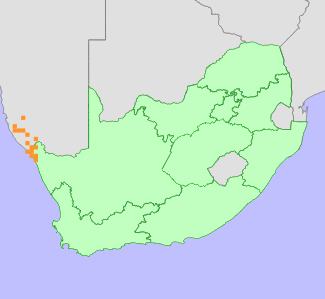|
Scientific Name | Lachenalia klinghardtiana Dinter |
Higher Classification | Monocotyledons |
Family | HYACINTHACEAE |
National Status |
Status and Criteria | Critically Endangered A3c+4ac |
Assessment Date | 2022/12/07 |
Assessor(s) | P.C.V. Van Wyk & D. Raimondo |
Justification | This species is an endemic to the Richtersveld and Sperrgebiet regions of South Africa and Namibia, the South African portion of the population is limited to a small area along the Orange River and the coastal plain between Alexander Bay and Port Nolloth. It has an extent of occurrence (EOO) of 632 km² and an area of occupancy (AOO) of 44 km². Between eight and 10 locations are currently declining due to the ongoing and accelerating impacts of open cast mining and habitat degradation as a result of overgrazing by livestock that took place between 2002 and 2016. At least 50% of the population has been lost since 2002. The majority (>90%) of the South African portion of the population falls within the proposed footprint for the development of the infrastructure associated with Boegoebaai Port and includes the construction of a green hydrogen plant, should this go ahead over 80% of the population will be lost by 2032. At the national scale this species therefore qualifies for listing as Critically Endangered under criterion A. While it is more widespread in Namibia, subpopulations there are disjunct and also declining due to the impacts of mining and climate change, the regional status of Critically Endangered is therefore not downgraded. |
Distribution |
Endemism | Not endemic to South Africa |
Provincial distribution | Northern Cape |
Range | Restricted to southwestern Namibia and the lower Gariep Valley to western Richtersveld, it occurs predominantly on the coastal plain between Lüderitz and Port Nolloth. |
Habitat and Ecology |
Major system | Terrestrial |
Major habitats | Northern Richtersveld Yellow Duneveld, Western Gariep Lowland Desert, Western Gariep Plains Desert |
Description | It grows in deep sands on flats and dunes. |
Threats |
| This species is threatened by current and future habitat loss and degradation. The portion of the population within South Africa occurs only along the Orange River and along the coastal plain between Alexander Bay and Port Nolloth. At least 50% of its habitat has already been lost to open-cast mining. Degradation extends far beyond the mining sites due to windblown dust from mining disturbances and exposed mine dumps covering large areas, burying this species' habitat in sand. The impacts of this degradation have been monitored with populations that were abundant around Alexander Bay having declined by over 80% since the year 2002. The entire South African portion of the population also falls within the footprint of the Boegoebaai Port development project being planned for implementation over the next 10 years. This development includes the construction of a Port for deep sea vessels, a railway line and several refineries for oil and other minerals as well as extensive renewable energy facilities to power a green hydrogen plant. The Namibian portion of the population is also subject to the impacts of open cast mining however this impacts less than 20% of the population at present, but a second green hydrogen facility is also being planned for Namibia and will be situated within this species range.
The population is furthermore declining due to climate change. Its entire range has experienced below-average rainfall since 2012. Predictions of future climate change include further increases in annual average temperature of between 1.4°C and 2.4°C by 2050, which will result in unbearably hot temperatures and ongoing aridification throughout significant portions of the year (Van Wilgen et al. 2017). Within South Africa several subpopulation declines have been monitored on the iNaturalist platform noting extensive loss due to the combined impacts of drought and habitat degradation as a result of mining. It has also lost habitat to severe overgrazing by livestock especially around Grootderm on the Orange River between the years 2002 and 2016. |
Population |
This species was formerly commonly found in both South Africa and Namibia however the South African portion of the population has declined by over 50% since the year 2002 due to the combined impacts of habitat loss and degradation caused predominantly by open cast diamond mining and livestock overgrazing. These declines have been further exacerbated by droughts attributed to climate change. All remaining subpopulations within South Africa fall within the proposed footprint of the Boegoebaai Port development and over 80% of the population will be lost by 2032 should this development go ahead.
|
Population trend | Decreasing |
Bibliography |
Snijman, D.A. 2013. Plants of the Greater Cape Floristic Region 2: The extra Cape flora. Strelitzia 30. South African National Biodiversity Institute, Pretoria.
Van Wilgen, N.J. and Herbst, M. 2017. Taking stock of parks in a changing world: The SANParks Global Environmental Change Assessment. SANParks, Cape Town.
|
Citation |
| Van Wyk, P.C.V. & Raimondo, D. 2022. Lachenalia klinghardtiana Dinter. National Assessment: Red List of South African Plants version 2024.1. Accessed on 2025/11/11 |
 Comment on this assessment
Comment on this assessment

